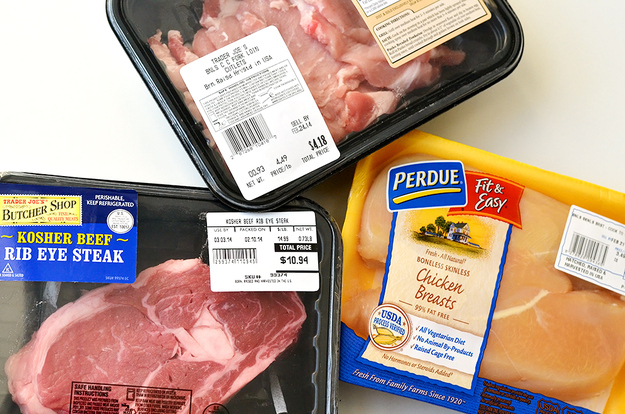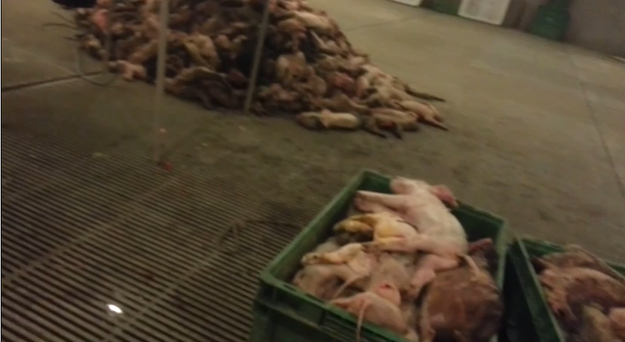NOBULL: How (Not) To Use The USDA’s New Meat Labels — BuzzFeed
How (Not) To Use The USDA’s New Meat Labels
To understand how far Americans are from knowing anything about the provenance or safety of grocery store meat, just look at the 12-year battle over Country of Origin Labels. (Warning: This post contains a photo of dead animals.) posted on March 5, 2014 at 10:47am EST
Deena Shanker BuzzFeed Staff
BuzzFeed / Macey J Foronda
Last month, Nestlé USA made an announcement that sent shockwaves through the after-school snack community: Two varieties of Hot Pockets were being recalled for potentially containing “diseased and unsound animals.” The culprit was California’s Feeding Corporation Rancho, a slaughterhouse and processing plant that had to recall 8.7 million pounds of beef, extending to 2,000 stores, including giants like Walmart and Kroger, in 32 states and Guam. Rancho’s bad meat likely made its way into other foods besides Hot Pockets. But you, the consumer, have no way of knowing which ones. That’s not public information — despite the sparkly new meat labels that the U.S. government just ordered into grocery stores.
But when the new labels appeared in November you may not have noticed, because it’s not like they’re brimming with information. They tell you in which countries your meat was born, raised, and slaughtered — the bare minimum of transparency already required of, say, fruit and vegetable producers. But it took 12 years, two sets of federal rules, two lawsuits, and a World Trade Organization dispute to put those labels there. Just last month they were challenged again in Farm Bill negotiations.
In fact, the story behind the Country of Origin Labeling (COOL) law opens a window into just how difficult and costly it will be for the government and the meat industry to give us information about where our meat comes from by the time it gets to the grocery store — especially if that meat is processed first.
Since it was approved by Congress and signed into law by President Bush in 2002, COOL has faced an uphill battle. An original version seemed simple enough — requiring grocery stores selling beef, lamb, pork, chicken, and goat to label the meat “with its country of origin.” But that task didn’t prove so easy; the U.S. government struggled to accurately describe packaged meat origins given the complexity of the industry. (I imagine the conversation went something like this. USDA: “So we could have two T-bones in one package, one from a cow raised in the U.S. and one from a cow born and raised in Mexico but slaughtered in the U.S. in the same package? And both would say ‘Product of USA’?!” Meat packers: “Yes. What’s the problem?”)
Then came the years and dollars spent by meatpackers and grocers who fought the labels at every turn, saying the cost of keeping animals separated was more than the meat industry could handle. On top of that, there have been protests from Mexico and Canada, who believe this law will hurt meat exports.
Against these odds, COOL prevailed, and the labels are now in place to tell you what countries these animals passed through before they ended upon your plate. But can you use them to help you avoid meat the USDA has decided could be unsafe? No. Can you use them to avoid meat raised in a way you might consider unethical? No. Can you actually use them at all? Not really.
Slaughterhouse workers dissect, sort, and separate beef parts. Under COOL, workers will not be able to process animals from different origins simultaneously. Flickr: 41284017@N08 / U.S. Department of Agriculture
Right now, there are more than 70 ongoing food recalls in the U.S., almost all of them for meat products. For consumers looking to avoid that meat, the new COOL labels aren’t helpful. The labels aren’t required for processed meats, which account for the majority of recalls. Plus, recalls are issued by names of companies or plants, and the new COOL labels don’t tell us company names or plant names, they tell us countries. Of these 70-plus recalls currently happening, two involve Canadian meat. But consumers can’t really in good conscience use the new COOL labels to avoid all Canadian meat just because one Ontario company, Santa Maria Foods Corporation, is recalling more than 10,000 pounds of various meat products.
An undercover Humane Society of the United States investigation found that Kentucky’s Iron Maiden Hog Farm was feeding the intestines of dead piglets (pictured above) to their mothers and other sows. humanesociety.org
You might also like to know which companies produced your meat so you could learn about the treatment of the animals you’re eating. A recent Humane Society of the United States investigation found, for example, that Kentucky’s Iron Maiden Hog Farm keeps pigs in cages so small that they can’t turn around for the entirety of their lives, and feeds the intestines of piglets who died from severe diarrhea back to their mothers and other breeding females.
These facts may not bother some consumers — or at least not enough that they will pay a premium for ethically raised meat. But what is the argument for denying us access to this information? Shouldn’t meat labels that take 12 years to become reality be addressing these issues? And if they don’t, what in the world took them so long?
“It’s a dollar and cents issue,” said Mark Dopp, general counsel for the American Meat Institute — the organization that led last July’s lawsuit against the USDA to stop the basic country of origin meat labels. AMI, an organization representing 95% of red meat processors in the U.S., says that in order to comply with COOL, livestock will need to be segregated by country of birth for the entirety of its lifespan and beyond.
For processors slaughtering thousands of animals every day that’s a huge and costly change, he said. The USDA estimates the label will cost the industry somewhere between $53.1 and $192.1 million. AMI believes it could cost significantly more, with estimates as high as $500 million for the cattle industry alone just to reconfigure processing plants to accommodate the new rules.
That’s a lot of money especially if, as Dopp said, consumers aren’t even interested in the information: “Independently generated data does not suggest that consumers care all that much about the country of origin.”
But that’s not exactly what the data has said. What the Kansas State University study Dopp referred to really found, according to the study’s lead author Glynn T. Tonsor, is that consumers regularly selected meat carrying origin information over meat that had no label at all. “What has been much less examined is if there is an actual willingness to pay by the public to back this preference,” Tonsor said. Another poll, conducted by the Consumer Federation of America in May 2013, found that 90% of Americans support labeling meat packages with the country of origin.
Bill Bullard, CEO of R-CALF, an association of domestic cattle producers that support COOL. R-CALF USA / Facebook: RCALFUSA
Another group opposed to the country of origin labels, who also contributed to the 12-year delay, are the meat producers of Mexico and Canada, the two countries most intertwined with the American meat system. They worry that grocery stores — which are the ones breaking down shipments of huge slabs of meat, putting it in packages and labeling those packages — will choose to carry all-American meat just because it’s simpler for them. A USDA study seems to confirm their concerns, finding that beef labeled with “Canada” or “Mexico” fetched lower prices than beef produced entirely within the United States. According to the Canadian Agriculture Minister, COOL could cost the country’s livestock sector $1 billion per year. Mexico and Canada went so far as to say the labels violate international trade agreements and are fighting it out with the USDA at the World Trade Organization. The Canadian government has threatened retaliatory tariffs against certain U.S. imports if the rules aren’t changed.
“What Canada and Mexico are really complaining about is that their products do not demand the same price in the U.S. marketplace,” said Bill Bullard, CEO of R-CALF, an association of domestic cattle producers that supports the labeling law. His group supports the law because it gives smaller American meat producers a better chance at competing.
The courts so far have upheld COOL, finding that the labels neither violate free speech rights, as the meat producers say, nor necessarily cost more than the industry can handle.
But the new labels still fall short of letting us know where our meat comes from. An ideal label could, at the very least, include the precise farm where the animal was born, the feeding operation where it was raised, and the slaughterhouse where it was processed. Armed with the names of the actual facilities, a concerned consumer could fairly easily find out more about their conditions on the internet, including the housing provided, the hormones and antibiotics administered, and the GMOs the animals were fed. It might take a few minutes to track down, and some facilities would have more details published than others, but any consumer actually interested could probably find some of the information they’re seeking.
It took 12 years, however, just to have the countries that the animals were born, raised, and slaughtered in listed. Imagine how long would it take to require meat labels to provide that kind of real information.



